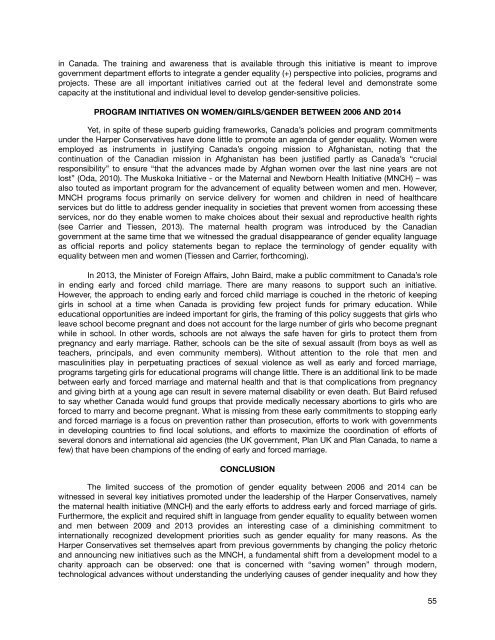Undercurrent-Issue-Fall-Winter-2014-3
Undercurrent-Issue-Fall-Winter-2014-3
Undercurrent-Issue-Fall-Winter-2014-3
You also want an ePaper? Increase the reach of your titles
YUMPU automatically turns print PDFs into web optimized ePapers that Google loves.
in Canada. The training and awareness that is available through this initiative is meant to improvegovernment department efforts to integrate a gender equality (+) perspective into policies, programs andprojects. These are all important initiatives carried out at the federal level and demonstrate somecapacity at the institutional and individual level to develop gender-sensitive policies.PROGRAM INITIATIVES ON WOMEN/GIRLS/GENDER BETWEEN 2006 AND <strong>2014</strong>" Yet, in spite of these superb guiding frameworks, Canada’s policies and program commitmentsunder the Harper Conservatives have done little to promote an agenda of gender equality. Women wereemployed as instruments in justifying Canada’s ongoing mission to Afghanistan, noting that thecontinuation of the Canadian mission in Afghanistan has been justified partly as Canada’s “crucialresponsibility” to ensure “that the advances made by Afghan women over the last nine years are notlost” (Oda, 2010). The Muskoka Initiative - or the Maternal and Newborn Health Initiative (MNCH) – wasalso touted as important program for the advancement of equality between women and men. However,MNCH programs focus primarily on service delivery for women and children in need of healthcareservices but do little to address gender inequality in societies that prevent women from accessing theseservices, nor do they enable women to make choices about their sexual and reproductive health rights(see Carrier and Tiessen, 2013). The maternal health program was introduced by the Canadiangovernment at the same time that we witnessed the gradual disappearance of gender equality languageas official reports and policy statements began to replace the terminology of gender equality withequality between men and women (Tiessen and Carrier, forthcoming)." In 2013, the Minister of Foreign Affairs, John Baird, make a public commitment to Canada’s rolein ending early and forced child marriage. There are many reasons to support such an initiative.However, the approach to ending early and forced child marriage is couched in the rhetoric of keepinggirls in school at a time when Canada is providing few project funds for primary education. Whileeducational opportunities are indeed important for girls, the framing of this policy suggests that girls wholeave school become pregnant and does not account for the large number of girls who become pregnantwhile in school. In other words, schools are not always the safe haven for girls to protect them frompregnancy and early marriage. Rather, schools can be the site of sexual assault (from boys as well asteachers, principals, and even community members). Without attention to the role that men andmasculinities play in perpetuating practices of sexual violence as well as early and forced marriage,programs targeting girls for educational programs will change little. There is an additional link to be madebetween early and forced marriage and maternal health and that is that complications from pregnancyand giving birth at a young age can result in severe maternal disability or even death. But Baird refusedto say whether Canada would fund groups that provide medically necessary abortions to girls who areforced to marry and become pregnant. What is missing from these early commitments to stopping earlyand forced marriage is a focus on prevention rather than prosecution, efforts to work with governmentsin developing countries to find local solutions, and efforts to maximize the coordination of efforts ofseveral donors and international aid agencies (the UK government, Plan UK and Plan Canada, to name afew) that have been champions of the ending of early and forced marriage.CONCLUSION" The limited success of the promotion of gender equality between 2006 and <strong>2014</strong> can bewitnessed in several key initiatives promoted under the leadership of the Harper Conservatives, namelythe maternal health initiative (MNCH) and the early efforts to address early and forced marriage of girls.Furthermore, the explicit and required shift in language from gender equality to equality between womenand men between 2009 and 2013 provides an interesting case of a diminishing commitment tointernationally recognized development priorities such as gender equality for many reasons. As theHarper Conservatives set themselves apart from previous governments by changing the policy rhetoricand announcing new initiatives such as the MNCH, a fundamental shift from a development model to acharity approach can be observed: one that is concerned with “saving women” through modern,technological advances without understanding the underlying causes of gender inequality and how they55


